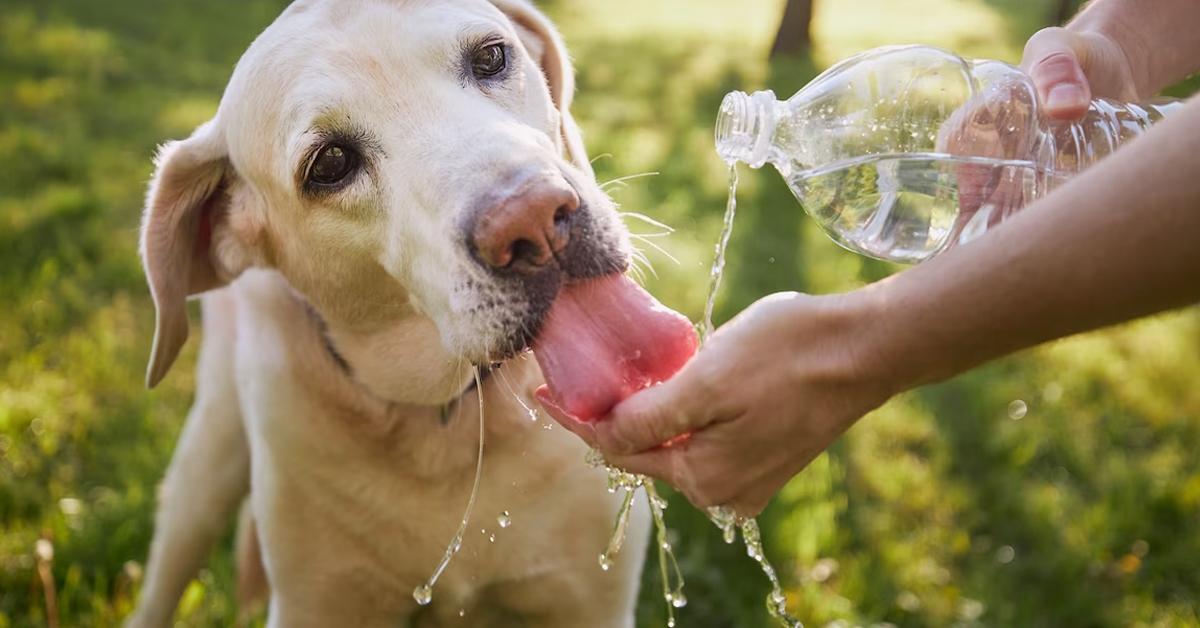This Is How To Keep Your Dog Safe In the Heat During Summer
Even if the weather is scorching hot it's important to remember that your dog still needs to go to relieve itself.

In times our planet has experienced its recorded temperatures and the impacts of climate change are only worsening. Severe weather conditions can have painful consequences, for dogs, such as burnt paw pads, heat exhaustion and even death. We spoke with Sarah Carotenuto, a professor at the University of Arizona College of Veterinary Medicine, who has 20 years of experience in emergency care. She provided us with advice on how to ensure the safety, activity and comfort of dogs during temperatures.
Is it too hot to take a walk?
It is important to consider whether your dog is accustomed to the weather conditions. If you have recently moved to an humid area and it is their time outside in such a climate it's best to proceed with caution. I recommend walking them during dawn or twilight hours so they can gradually adapt to the environment. Ensuring that they are properly acclimated is a step. You can determine if the pavement is too hot for your dogs paws by placing your hand on it for five seconds. If it feels uncomfortable for you then it's too hot for them.
How long should you walk your dog in heat?
When it comes to heat the duration of the walk should be minimized. It's essential to prioritize your dogs safety and wellbeing in these conditions. Consider shortening the length of the walk compared to what you would do, in cooler weather.
Remember that dogs can overheat quickly so it's best to keep their activity level low and offer opportunities for them to rest and cool down. If you or your partner are overweight or, out of shape its not recommended to start an exercise routine during the summer. To keep your dog comfortable I suggest taking them for a walk during the part of the day.
Limit it to 10 to 15 minutes. Inside make sure your dog has the opportunity to cool down easily. If they're panting excessively or have ears and canines that don't stop after five minutes it's a sign they're overheated. If they show no interest in continuing the walk it's an indication they've had enough. In temperatures walks are only necessary, for bathroom breaks and some fresh air.
Remember that dogs can overheat quickly so it's best to keep their activity level low and offer opportunities for them to rest and cool down. If you or your partner are overweight or, out of shape its not recommended to start an exercise routine during the summer. To keep your dog comfortable I suggest taking them for a walk during the part of the day.
Limit it to 10 to 15 minutes. Inside make sure your dog has the opportunity to cool down easily. If they're panting excessively or have ears and canines that don't stop after five minutes it's a sign they're overheated. If they show no interest in continuing the walk it's an indication they've had enough. In temperatures walks are only necessary, for bathroom breaks and some fresh air.
To keep your dog cool while walking bring water for them to drink and consider using a misting fan if available. It's important to ensure your dog doesn't go without water for long.
After the walk help your dog cool down by providing water. You can give them ice cubes or frozen low sodium chicken bouillon to lick on for hydration and refreshment.
Are there dog breeds that're particularly sensitive, to heat?
There are a breeds that require attention during the summer months. The first category includes Arctic breeds or any dogs that have traits for sledding. These breeds have undercoats that protect them from the cold. Unfortunately they also tend to retain heat. Another category is made up of breeds with fur like herding dogs.
Another group of dogs that struggle with heat are brachycephalic breeds, which have faces. The normal anatomy of these dogs is compressed into a muzzle making it harder for them to regulate heat and oxygen exchange through panting, which's their primary way of cooling down.
Are there any preexisting conditions or characteristics in dogs that can make them more vulnerable to heat?
like in humans excess weight can make it more challenging, for dogs to handle weather. So overweight dogs may find it harder to cope with the heat. Older dogs, with arthritis may experience difficulties walking which puts them at a risk of heat exposure. It's also important to note that dogs with preexisting issues are more susceptible to heat related problems.
Which heat related emergencies are commonly observed in dogs?
One common heat related emergency we often encounter is when pets are left outdoors and suffer from heatstroke. This is a situation because when a dogs body temperature surpasses 107 degrees Fahrenheit it affects the proteins in their body, which can lead to blood clotting issues.
I often explain it to owners using the analogy of an egg. When you cook an egg it changes from a state to solid. You can't reverse the process. Similarly when a dogs body overheats the proteins undergo changes that can be extremely dangerous. Once this happens dogs become more prone to heatstroke episodes. Can develop severe secondary conditions.
I often explain it to owners using the analogy of an egg. When you cook an egg it changes from a state to solid. You can't reverse the process. Similarly when a dogs body overheats the proteins undergo changes that can be extremely dangerous. Once this happens dogs become more prone to heatstroke episodes. Can develop severe secondary conditions.
When is it necessary to seek care for a dog?
If your dogs temperature exceeds 107 degrees it is considered an emergency. The first step, in providing relief is to cool them down using water, not ice water. To determine if your dogs paws are burned one noticeable sign is when they start shifting their weight from the limb. Often dogs also lick their feet. When you flip their paw you might notice that the little pads have peeling skin, which can be quite painful. In cases it's advisable to seek assistance.
If your dog has paw burns there are a things you can do at home. One option is to wash the area with soap and water and then apply aloe vera gel. Another safe alternative would be using something, like Neosporin.
Considering the weather many owners might want to let their dogs swim or play in water. However it's important not to assume that all dogs know how to swim. It's essential to supervise them. I highly recommend using a life vest for your dog particularly if they'll be on a boat.
Another thing to be cautious about is when dogs start biting at spray hoses or sprinklers while playing in water. It may seem entertaining. If they can't control themselves and keep drinking amounts of water it can lead to acute water intoxication. This condition occurs when the sodium levels, in the body become too diluted and can result in brain swelling. It's crucial to watch your dog when they're, near water during their initial interactions, with it.


